The Word Editor
Abstract
The Word Editor is designed for individuals who have almost no limb movement. The software includes an on-screen keyboard which offers features unavailable in commercially-available on-screen keyboards. A specially designed mouse with touch pads is used as an alternative mouse for cursor control. The software and the mouse can be used separately and are useful for people with or without disability. A prototype is currently being used in Apollo hospitals Pvt Ltd, India.
Keywords
Assistive technology, computer access, onscreen keyboard, alternative mouse
Background
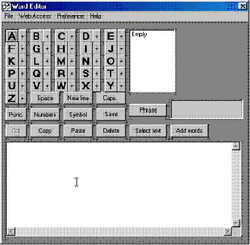 |
|---|
Approximately nine million out of total population of over nine hundred and seventy three million people in India have some kind of physical impairment [1].
Individuals with neuro-motor disorders find it difficult to access the computer which makes it difficult to pursue educational and vocational goals. A national survey on disabilities in the US found that two-thirds of working-age adults with disabilities were not employed and that nearly 80 percent of them wanted to work [2]. In a recent study, employment in individuals after rehabilitation rose from 18.8% to 85.4% [3]. These figures motivate our efforts to develop innovative technologies to help individuals with disabilities lead an independent life.
Statement of the problem
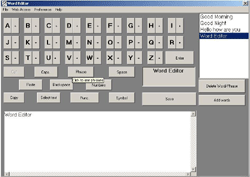 |
|---|
The Word Editor was originally designed for an eighteen year old boy with quadriplegia due to an accident. He wanted to access a computer for information exchange and entertainment, but couldn't find a cost effective solution to his problem. His additional requirements such as text macro, direct access to the Internet and variable word scrolling rate were some of the features which were not incorporated in any of the commercially-available onscreen keyboards. Moreover, by writing the software we had the ability to modify its features and add new functionality, which is not possible in commercially-available versions.
Approach
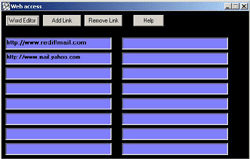 |
|---|
The initial stage of the project was to study the patient's cognitive, physical & sensory abilities and his needs. After a brainstorming session and discussion with the neurosurgeon, experts from Indian Institute of Technology and the patient, a frame work for the design and features for the virtual keyboard was established. For cursor control, various methods were considered and implemented before an approach was found appropriate.
Solution
Software
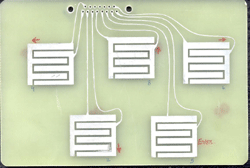 |
|---|
The primary aim of the software is to type, edit, save and retrieve data. The software is written in Visual Basic (VB) 6.0 because it is easy to design user interfaces in VB and it provides a good platform for user-based applications. Almost all the features required like cut, copy, paste, punctuation, symbols, numbers etc are provided. The Word Editor interface includes a list of frequently used words and phrases that can be accessed with a single mouse click. The user can add and remove words and phrases from the list and set the rate at which the user can scroll through the list.
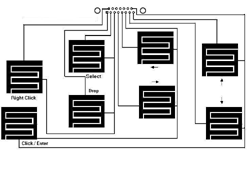 |
|---|
The display is simple and attractive, with buttons arranged in alphabetical order. The QWERTY pattern was originally designed for manual typewriters to prevent key jamming (Struck, 1999), but this is no longer a problem with electronic keyboards. In fact individuals with visual, auditory and cognitive disabilities have reported problems with the QWERTY layout (Fong Lee, 1995) [4]. Instead, an alphabetical arrangement of the keyboard has been shown to be more efficient than the QWERTY pattern for some individuals and was found to be more suitable for our client. Next to each letter key is a button labeled with a '+' which, when activated, displays a list of words beginning with that letter. Button placement was evaluated over several iterations before a final layout was chosen.
Thumb.gif) |
|---|
Thumb.gif) |
Another feature of the software is that it is linked to the internet. The user can type the URL of a site and by clicking it will be connected to the net through Internet Explorer. The user can save frequently visited sites to avoid retyping the URL in the future.
Hardware
A mouse pad that contains eight contact pads was designed for the use with the Word Editor software. Four of the pads control movements of cursor, one acts as the 'enter' key of the keyboard, another one acts as the right click of the mouse while remaining two are provided for selecting and deselecting an icon for dragging & dropping and are used for playing games.
The mouse pads' size and orientation were designed to match the motor skills of the patient. The contact pads which were least frequently used were kept farthest from the center of the pad to save time & effort for the user. The 'enter pad' was moved away from the direction keys to avoid unintentional activations, which was likely as the patient does not have control over his hand.
As a further enhancement, and also as required by the patient, the mouse was made wireless by interfacing Infrared (IR) source and receiver. The IR source was a TV remote control in which eight keys were interfaced with the corresponding mouse pads and the receiver was interfaced with the keyboard of the computer. Touching a mouse pad activated the corresponding key on the remote control and the corresponding pulse generated was latched with the help of a relay. Using timers, the user's input was latched for a predetermined interval (7-10 seconds) and then the system reset to allow new input from the same or other pad. This prevented multiple interrupts and allowed the patient to keep his hand on the pad if he wanted to use the same key repetitively.
RESULTS
The project was tested on three different able bodied subjects and finally on the client.
Initials |
Age |
Comp Skills |
Ease/ satisfaction* |
Remarks |
|---|---|---|---|---|
R M |
23 |
Novice |
Completely satisfied |
Good |
R Y |
26 |
Good |
Satisfied |
Good |
S S |
24 |
Expert |
Required the prototype to be interfaced with other applications like Matlab |
Complete functionality would require system level programming which is not required at this moment as its aim is to provide computer access to a paraplegic not to any computer wizard |
| * Satisfaction was based on a one page write up with respect to time and accuracy compared with Microsoft's speech recognition software. Despite spending many hours with each subject training the computer for speech recognition subjects still achieved only poor efficiency with speech recognition software. | ||||
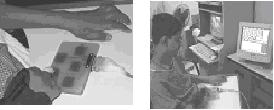 |
|---|
The patient was contacted after using Word Editor for three months. He was happy with the prototype and showed confidence & interest in life. He himself browsed the internet for different assistive technologies and medication using this prototype. His subsequent test in biofeedback in Apollo hospital also validated these results. Word Editor definitely helped him out of his mental depression but it is difficult to access the extent of its role.
Future Work
Using ActiveX control of VB and with slight modifications, a more interactive and useful prototype can be designed that incorporates many features of the Windows operating system. In addition, instead of controlling cursor by hand, voice control or eye gaze should also be explored.
References
- http://www.jmk.su.se/global99/access/physical/intphtxt.html#statics (1999) Javed Abidi, Secretary - General, Disabled Peoples' International in India.
- Louis Harris (1996) - Disability Studies: What it is and Why it is Needed? - Herald 25(4), February 12
- http://www.ed.gov/about/offices/list/osers/rsa/index.html (1995) - administrative data from the Rehabilitation services Administration.
- Denis Anson (2001)-Efficiency of the Chubon versus the QWERTY keyboard-Assistive Technology, 13(1), 40-45
Acknowledgements
I thank Prof Sneh Anand (CBME, IIT Delhi), M/s Jayshree Santhosh (CSC, IIT Delhi) and Dr. Rajendra Prasad (Apollo Hospital) for giving me the opportunity to work on this project.
Author Contact Information:
Abhishek Agarwal
University of Pittsburgh
5065 Forbes Tower
Pittsburgh,
PA 15260
Office Phone (412) 383-6795
EMAIL: aba13@pitt.edu
